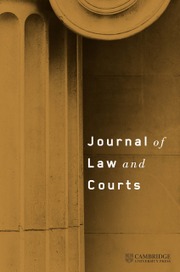No CrossRef data available.
Article contents
280 Characters of Contention: Analyzing Partisan Behavior on Twitter During Supreme Court Confirmation Processes
Published online by Cambridge University Press: 11 November 2024
Abstract
We analyze a cache of tweets from partisan users concerning the confirmation hearings of Justices Brett Kavanaugh, Amy Coney Barrett, and Ketanji Brown Jackson. Using these original data, we investigate how Twitter users with partisan leanings interact with judicial nominations and confirmations. We find that these users tend to exhibit behavior consistent with offline partisan dynamics. Our analysis reveals that Democrats and Republicans express distinct emotional responses based on the alignment of nominees with their respective parties. Additionally, our study highlights the active participation of partisans in promoting politically charged topics throughout the confirmation process, starting from the vacancy stage.
- Type
- Research Article
- Information
- Copyright
- © The Author(s), 2024. Published by Cambridge University Press on behalf of the Law and Courts Organized Section of the American Political Science Association


